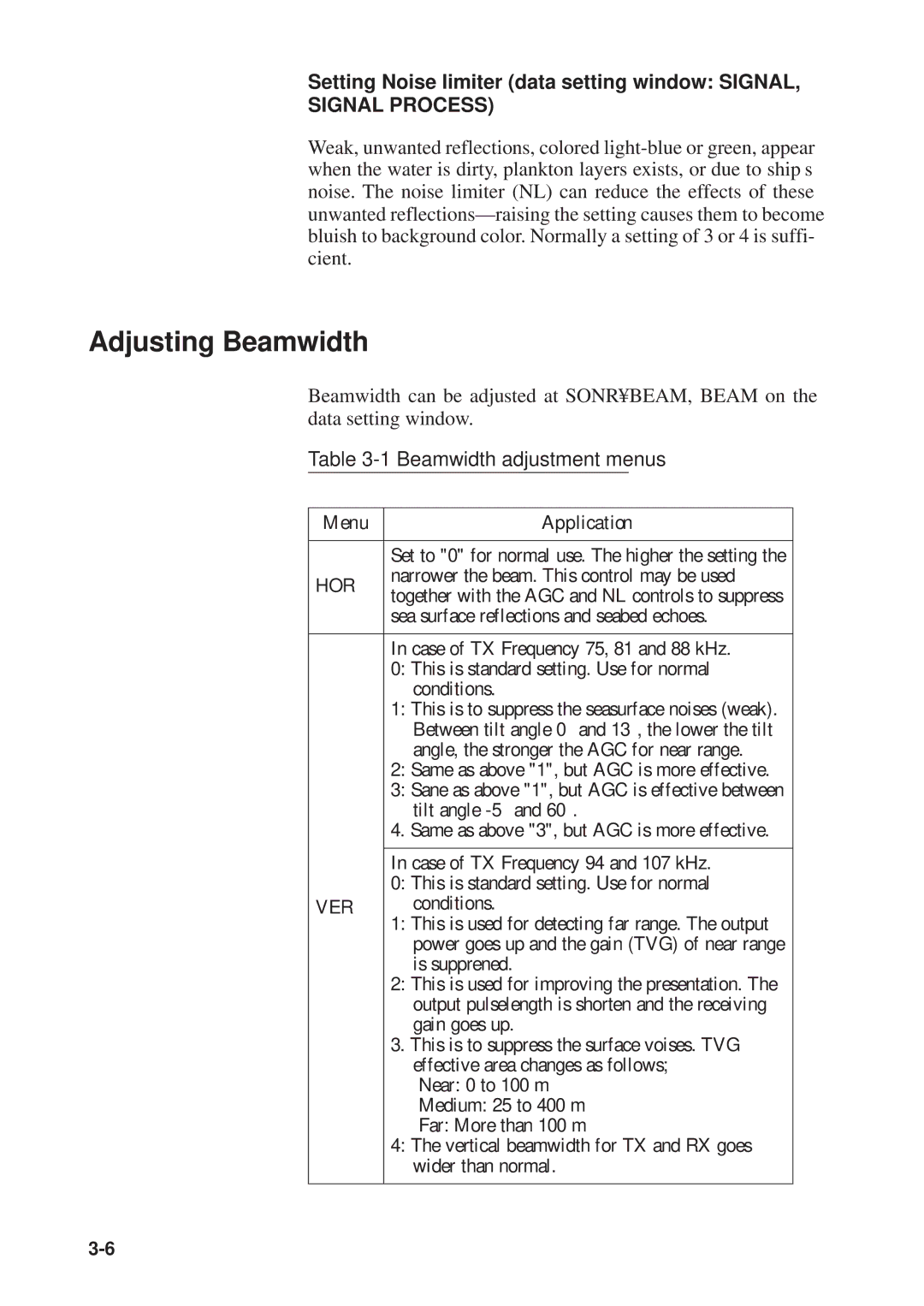Color Scanning Sonar
00080806600
Safety Instructions
Do not use the equipment for other than its intended purpose
Table of Contents
PORT/STARBOARD, Horizontal Slice Displays
Self Tests
This page is intentionally left blank
Word to CSH-83/84 Owners
Features
Foreword
System Configuration
Standard Option
Control Layout on Display Unit and Remote Control Box
Control Description
Main Panel
Main panel control description
Control Function
Sub Panel
END
Sub Panel 2 data setting window
Signal
AGC
Process
2AGC
Alarm
Sonar
UP/TM
Sonrbeam
Remote Control Box
+ +
Turning the Power On/Off
Adjusting Screen Brilliance, Control Panel Backlighting
Operational Overview
Lowering the Transducer
Selecting a Display Mode
Display mode description
Seabed echo and tilt angle
Setting the Tilt Angle
Selecting a Display Range
How to discriminate fish echoes from the seabed
Points to consider
Tilt angle for surface fish
Tilt angle and sea surface reflections
Suitable tilt angle
Tilt angle and beam coverage
Adjusting the Gain
Measuring Range and Bearing to a Target
Page
Eliminating Unwanted Feeble Echoes
Fine Tuning the Picture
How to adjust TVG
Page
AGC data setting window SIGNAL, Signal
Pulselength data setting window TVGTX,PL
2AGC data setting window SIGNAL, Signal Process
Suppressing Seabed Tail
Identifying noise source
Data setting window TVGTX, Output
Rejecting Sonar Interference and Noise
Changing Tx cycle data setting window Tvgtx
Cycle
Adjusting Beamwidth
Setting Noise limiter data setting window Signal
Marks and Data
Marks, Data and Display Mode
Normal display mode
Normal display mode w/text
Echo sounder combination display
Permanently Displayed Marks and Data
History display
Erasable Marks and Data
Mark/Data Description
Bearing marker
Mark Description
Range R Auto Tilt Auto Scan Gain Brill TVG TVG DIM
Page
Menu Overview
User Menu Operation
Menu screen location and display mode
User Menu Hist DSP/GRPH
User Menu Description
Current VEC
Save Picture
System Menu Description
FAR TVG
TM DSP
Target Lock
BRG Readout
Mark Size
Menu Description
Data SET Menu Description
Color Curve
Change Color
NET Shoot
Plan
NET Sonde
NET Plot Corr
Init SET/TEST Menu Description
Defaults
Echo Test
NET REC
Others Event KEY
Function Keys
Programming the Function Keys
Function Key Fine Tuning
Replaying a Function Key
Saving Function Key Settings to a Memory Card
Replaying Function Key Settings from a Memory Card
This page is intentionally left blank
Finding Fish School Center
How to find fish school center
Advanced Level Operation
Tracking a Fish School target lock
Tracking a fish school
Erasing target lock mark
Choosing target lock mode
Target lock mark appearance
Tracking target lock mark
Target lock and tilt angle
Setting target lock conditions
System Menu Target Lock
Description of target lock items
Detecting Fish Schools Aurally
Fish Alarm
How to set the fish alarm zone
How to relocate fish schools
Relocating Fish School for Easy Observation
Comparing of Fish School Concentration
Estimate marks and their data
How to measure fish speed
Measuring Fish School Speed
Event Mark
10 Event marks
Entering an event mark
Erasing an event mark
True Motion Display
12 True motion display
Plotting Net Location Mark
13 Net location mark
Observing Net Behavior
14 Net behavior
Target Slice Display
No. Display Information Applications
This page is intentionally left blank
PORT/STARBOARD, Horizontal Slice Displays
Port/Starboard display
Horizontal slice display
Horizontal slice display
Memory Card Operations
Initializing Memory Cards
Saving the Picture
Transferring Echo Data from Internal Memory to Memory Card
Net shooting data contents
Saving Net Shooting Data
How net shooting data is saved
Transferring net shooting data to memory card
Deleting Memory Card Contents
Replaying Saved Data
Turning marks on/off through the user menu
Turning marks on/off through the data setting window
Turning MARKS, Data ON/OFF
10-2
Interpreting the Display
Seabed Echoes
Fish Schools
Sea surface fish
Sea Surface Reflections
Wake
False Echo by Sidelobe
Noise and Interference
Overvoltage Warning
Unretracted Transducer Warning
How to manually raise the transducer
Self Tests
Opening the Self Test Menu
Continuous test
Self Test Description
Single test
Panel test
Color test
Gray test
SIO test
Interface Unit CS-120A Self Test
Interface unit CS-120A, cover opened
13-6
Input Data Selection
Selection of Data at Interface Unit CS-120A
Setting Distances Between Net Sonde Transmitters
How to set net sonde transmitter distances
Maintenance
Display Unit Maintenance
Hull Unit Maintenance
Zinc block near the transducer must be replaced yearly
Menu Tree
User Menu
Data SET Menu
Init SET/TEST Menu
System Menu
Previous
Page
Specifications
SP-1
Display
SP-2
Hull Unit
SP-3
SP-4
Index
11-2
IN-2
